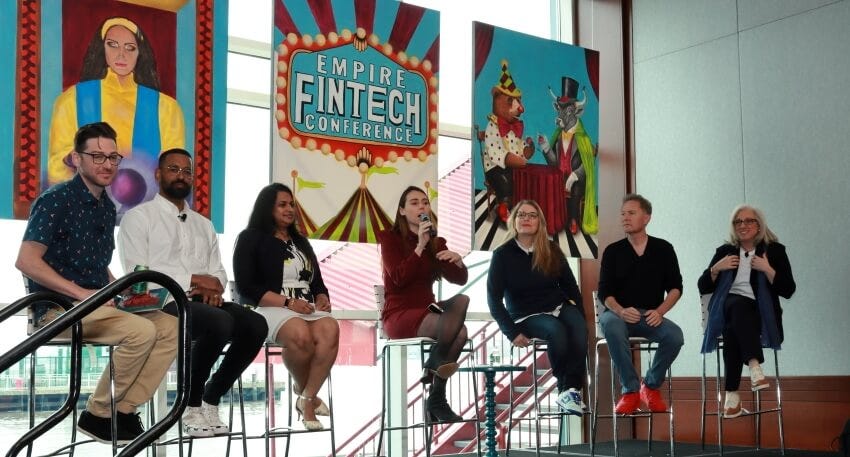AI, Bitcoin, and Distilled Spirits at New York Fintech WeekAI, Bitcoin, and Distilled Spirits at New York Fintech Week
Pragmatism and ambition are at play in the thaw that gives some hope after the last crypto winter.

Finding ways to ground high-flying prospects of technology in real-world opportunities is an ongoing challenge, especially with the rush of AI hype and other innovations that make big promises for the future. Startups and incumbents in the financial world discuss how their space continues to evolve during this year’s New York Fintech Week.
In the hours after Monday’s eclipse cast its shadow across the region, the New York Tech Meetup, in conjunction with Blockchain NYC, held an evening of demos that included Lendvest’s ideas to make financial markets on blockchain more efficient, and BlockBar using blockchain to verify the quality of valuable wines and spirits sold on its marketplace.
Later in the week, Empire Startups' New York Fintech Conference included some discussion on who has the edge with AI -- fintechs or incumbents -- and a separate talk on where blockchain may be headed in 10 years.
Demoing at the New York Tech Meetup, Essence Slomianski, director of operations at BlockBar, said her company is a global marketplace that offers high-quality wines and spirits direct from producers to consumers, with the transactions authenticated on the blockchain. She said the pain point BlockBar wants to address is the concern that valuable wines or spirits, sold at auction for example, are what they claimed to be and not counterfeit.
“You can buy a bottle at Sotheby’s or Christie’s and if the bottle turns out to be fake, forged, whatever it is, there’s no recourse for that,” she said, “and they pretty much can’t do anything for you. So, the idea is that -- we call them asset-backed NFTs -- so they’re NFTs backed by the physical bottle of alcohol and the actual bottle never trades hands until it’s redeemed.”
When the new owner redeems the bottle, they will receive a digital receipt declaring their ownership. BlockBar works directly with producers, Slomianski said, with no third parties in the mix.

Essence Slomianski at the NY Tech Meetup. Photo by Joao-Pierre S. Ruth.
Other startups that demoed at the meetup included:
Modelex -- A large language model-based provider of on-chain data, such as sentiment scores, meant to connect the value proposition of AI and blockchain.
nCent -- A privacy-first, data market that offers consumers control over and the ability to monetize their data while also offering companies precise data made available from consumers.
Folks Finance -- A decentralized finance protocol that provides financial tools to manage digital assets.
K3 Labs -- Offers easy design and deployment resources for applications and business workflows through decentralized compute and storage.
Shifting gears to some bigger picture fintech topics, on Wednesday, the New York Fintech Conference featured a discussion on “Who Will Win the AI Race, FinTechs or Incumbents?” with Akita Somani, senior vice president, BNPL/POS lending at U.S. Bank; Drew Glover, co-founder at Fiat Ventures; Jesse Reiss, co-founder at Hummingbird RegTech; Ally McCloskey, principal at Clocktower Technology Ventures serving as moderator; Laura Kornhauser, CEO at Stratyfy; Melissa Otto, who leads the innovation lab for tech, media, telecom at Visible Alpha; and Peter Hazlehurst, CEO at Synctera.
Part of what can give banks an edge over smaller, scrappier fintechs may be the bevy of bank data that AI could sink its digital teeth into. “Banks today already have a lot of data sets, both internal and external, because they already have partnerships with the likes of credit bureaus, trading data, and other providers out there,” said Somani, “which means that they have access to a very wide range of data sets, which they can connect and leverage using AI.”
Another benefit for incumbent banks, she said, is they have live use cases that they are trying to solve for. “They can actually test, learn, evolve pretty quickly, leveraging the data sets and the use cases that they have to see if they’re getting the outputs that they're expecting.”
Incumbent banks can also get product to market and in front of customers more quickly than a fintech that has yet to establish itself. “Banks have the largest sandbox in the world because of the infrastructure they’ve built and the history they have with data,” Reiss said. “The ability to structure that data with the power of AI, and then being able to deploy that into the market across their partnerships, and their existing infrastructure across a long line of products -- both B2B and B2C -- they have the ability to learn the fastest and be able to deploy to the market the fastest.”
Though fintechs are often known for nimble experimentation, they still need data to fuel their efforts, which gives weight to incumbent banks exploring AI. “With the AI models that we have today,” Glover said, “the data is still relevant, is still necessary. What we see from the banks, where they can provide unique data sources, unique data resources that will still be relevant and important for this new generation of AI.”

Jesse Reiss, Drew Glover, Akita Somani, Ally McCloskey, Laura Kornhauser, Peter Hazlehurst, and Melissa Otto at the New York Fintech Conference. Photo by Joao-Pierre S. Ruth.
Speaking up for the prowess of fintechs, usually unfettered by the baggage incumbents may carry, Kornhauser pointed out where the incumbents may have a hard time delivering on certain promises with data and AI. “Banks may have a lot of data, they sure do, but can they access it and can they unify it in a way that it can be leveraged by AI or machine learning models in a scalable way?” she asked. “We find often that that is a massive challenge at financial institutions.”
What can be a particular challenge for banks, she said, is actually accessing data, pulling it out, and then joining it with data that came from elsewhere. “While a number of financial institutions have made real big strides in fixing this problem, and I would urge all to do that going forward, the current state of affairs with those banks is not a lot of easy access to that data, which doesn’t enable speed, innovation, efficiency at all,” Kornhauser said.
Possessing mountains of data does not necessarily mean much of it will be usable though, especially given the governance banks must adhere to -- with good reason. “While it is a big sandbox, it’s more of a desert than a sandbox,” Hazlehurst said. “There’s a lot of sand out there but you can’t actually do anything with it. I used to work at a company called Yodlee and our customers were among the top 40 banks in the US -- they couldn’t use our own data for themselves for their own benefit. The problem you have with big banks is the governance and the rules around access to the information and then using it for actually useful stuff. You may have these vast rows of data, but you can’t touch it.”
The regulatory demands on banks can lead to constraints on how the data can be used and how it can be trained, Otto said. “How can it actually be put to the cloud and be made available for something with a generative AI, a tool, or a bot?” she asked. “I have a feeling that someone in the [US Securities and Exchange Commission (SEC)] might have things to say about that.”
Bitcoin's Value Hinges on Its UX
That discussion was followed by a debate on “Is Bitcoin more likely to be at zero or a million in 10 years?” moderated by Zach Anderson Pettet, US content director with Money20/20 and host of the Fintech Family Hour podcast. The panel brought together Alice Nawfal, COO at Notabene; Anthony Scaramucci, founder and managing partner of SkyBridge Capital; Danielle Nicholson, founder and CEO at Builderbloc; Jamiel Sheikh, CEO at Scifn; Laurence Latimer, co-founder and CEO at Dinara; and Matt Zhang, founder and managing partner at Hivemind Capital Partners.
Nicholson said more platforms utilizing Bitcoin are part of what drives its price forward. “The way the rest of the world has embraced Bitcoin, first the US, but we’re inching in the right direction,” she said.
Though Bitcoin’s price was about $69,000 at the time of the conference, there has been uneven adoption of it and other cryptocurrency among the general public, especially after the latest crypto winter and regulators cracking down on rulebreakers. Giving a bit of a bearish take on how the user experience may be a factor, Nawfal said when she got into the cryptocurrency space in 2017, expectations about crypto and Bitcoin were high, but it was not easy to engage with because applications were a challenge to use. “Here I am in 2024 and we kind of haven’t moved that much forward,” she said. “It’s still really hard to use crypto applications outside of centralized exchanges like Coinbase.”
Managing cryptocurrency, while trying to not lose it, she said, can still be a complex process. “Last year, I was buying an NFT on MATIC [the cryptocurrency of the Polygon network] and it took me 11 steps, 30 minutes, to be able to execute the transaction,” Nawfal said. Figuring out the user experience, Nawfal said, could be crucial to wider adoption.
Sheikh, who also leads Blockchain NYC, offered another sobering perspective as he described some of the issues users can face with cryptocurrency and the lack of clear paths of action to resolve problems. “I started mining Bitcoin in 2012 on a Sony Vaio laptop,” he said. “Today I don’t have those Bitcoins because I can’t get to my laptop.” Sheikh said he tossed out the laptop in frustration at the time, leaving perhaps 20 to 30 Bitcoins behind -- which he cannot access now. “If that’s not bad UX, I don’t know what is. Who do I call?” he asked. “I can’t call anybody.”

Jamiel Sheikh, Alice Nawfal, and Laurence Latimer. Photo by Joao-Pierre S. Ruth.
Scaramucci, who once served a rather brief stint as White House communications director under the prior administration, is no stranger to playing at the high-stakes table. He said big opportunities could be realized from Bitcoin once it gets rolling with the mainstream. “I want to take everybody back to 1998,” he said. “We’re Web 1. We have a fat screen computer. We have a modem under the desk whirring and burring and we have a 35-second wait for our landing page to arrive. You’re describing Web 3, as if it’s 1998 in terms of its adoption.”
Taken from that perspective, the growing pains Bitcoin and the crypto market contend with now might be seen as the beginning of a major sea change -- if it can catch on the way the internet eventually did from its early days. Scaramucci continued, “Imagine if I came from the future -- 2024, and I said to you when you were waiting for your AOL or Prodigy account to load, and you were going to buy a PEZ gun from eBay or a book from Amazon and I said, ‘This highway is going to widen to trillions of dollars in transactions on it. Moreover, there will be billions of people downloading 4k video on this.’”
Sheikh countered to cool such speculation, noting there is a difference between the public realizing products could be ordered online and embracing the tech versus getting onboard with crypto. “The adoption time for the general public for Web 2 was pretty immediate,” he said. That included learning emails could be sent instantly rather than physical mail taking days. Delving into crypto, on the other hand, is still outside of most people’s daily routines. “The adoption time for Web 3 is much larger because, en masse, people are not using crypto for regular activity,” Sheikh said.
For his part, Zhang spoke up about prospects he foresees with NFTs and the future of blockchain, even if it may take some time to realize. “We think blockchain is going to play a big role in some applications, not today but in the next few years,” he said. Zhang cited, for example, the potential for blockchain to serve as a way to ensure artists get paid fairly for their creations and for collectors to demonstrate custody of the art. There is also a smart contract element he said can enforce payments to artists. “They will tell you how life-changing that is when they continue to receive payments for something they created five years ago,” Zhang said.
About the Author
You May Also Like






